Picture this: You’re running a thriving BigCommerce store in India, orders are pouring in from across the country, but your warehouse operations are becoming a nightmare. Inventory mismatches, delayed shipments, and frustrated customers – sound familiar? You’re not alone. As India’s ecommerce market continues its explosive growth, businesses are discovering that success isn’t just about getting orders; it’s about fulfilling them efficiently.
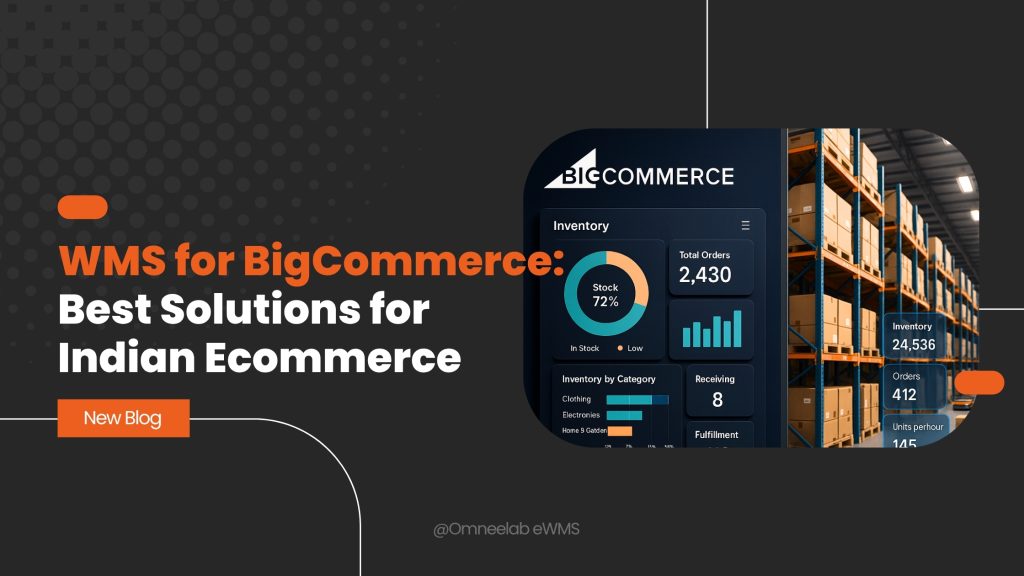
This is where a WMS for BigCommerce becomes your secret weapon. A warehouse management system can transform your chaotic operations into a well-oiled machine, helping you scale without losing your sanity. Whether you’re a growing startup or an established enterprise, understanding how to choose and implement the right warehouse management software for BigCommerce could be the difference between thriving and merely surviving in India’s competitive ecommerce landscape.
What is a WMS for BigCommerce?
Before we dive into the best solutions available in India, let’s get our basics straight. A BigCommerce warehouse management system is specialized software that integrates directly with your BigCommerce store to manage and optimize your warehouse operations. Think of it as the brain that coordinates everything from the moment an order is placed to when it reaches your customer’s doorstep.
Unlike basic inventory tracking, a comprehensive WMS for BigCommerce handles complex operations like real-time stock updates, automated order routing, pick list generation, and shipping optimization. It’s essentially your digital warehouse manager that never sleeps, never makes calculation errors, and can handle thousands of orders simultaneously.
For Indian ecommerce businesses, this becomes particularly crucial given the diverse market dynamics, varying shipping requirements across different states, and the need to manage both B2B and B2C fulfillment from the same facility.
Why Indian Ecommerce Businesses Need WMS for BigCommerce
The Indian Ecommerce Challenge
India’s ecommerce sector is unique. You’re dealing with customers spread across 28 states, multiple languages, varying payment preferences, and complex logistics networks. Add to this the seasonal spikes during festivals like Diwali, Dussehra, and regional celebrations, and you’ve got a perfect storm that can overwhelm manual warehouse operations.
BigCommerce inventory management India requirements are particularly demanding because:
- Scale complexity: What works for 100 orders per day falls apart at 1,000 orders
- Multi-channel selling: You’re probably selling on BigCommerce, Amazon, Flipkart, and maybe your own marketplace
- Seasonal variations: Festival seasons can increase order volumes by 300-500%
- Geographic diversity: Shipping to remote areas requires different handling than metro deliveries
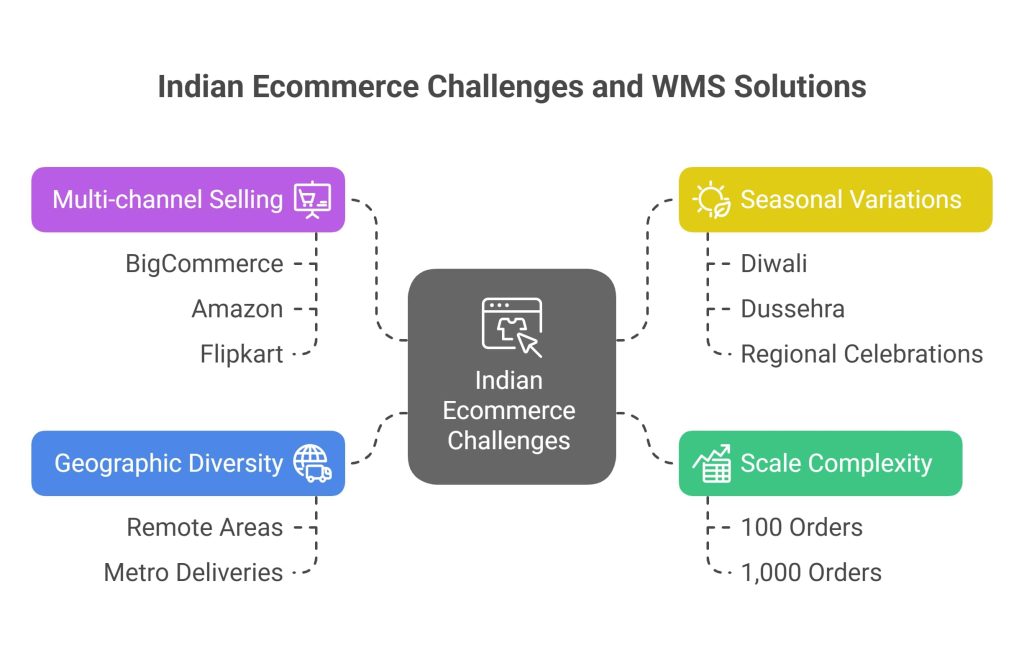
The Cost of Poor Warehouse Management
Here’s something most business owners don’t realize until it’s too late: poor warehouse management doesn’t just slow you down – it actively costs you money. Consider these real-world scenarios:
- Overselling: Without real-time inventory sync, you might sell products you don’t have, leading to cancellations and customer dissatisfaction
- Dead stock: Poor visibility means you might keep ordering products that aren’t moving, tying up valuable capital
- Labor inefficiency: Manual processes mean your team spends more time searching for products than actually fulfilling orders
- Shipping errors: Wrong products or quantities damage your brand reputation and increase return costs
A proper BigCommerce WMS integration addresses all these issues while providing the scalability you need to grow.
Key Features to Look for in a BigCommerce WMS
When evaluating warehouse management software for BigCommerce, you shouldn’t just look at the price tag. The right system needs to handle your current operations while providing room for growth. Here are the essential features that matter for Indian businesses:
Real-time Inventory Tracking
Real-time inventory tracking BigCommerce isn’t just a nice-to-have feature – it’s absolutely critical. Your WMS should update stock levels across all channels the moment an order is placed, picked, or received. This prevents the embarrassing situation of overselling during high-traffic periods like flash sales or festival seasons.
Multi-warehouse Support
As your business grows, you’ll likely need multi-warehouse support BigCommerce functionality. Whether you’re expanding to different cities or using a hybrid model with your own warehouses and third-party logistics, your WMS should handle inventory across multiple locations seamlessly.
Automated Order Processing
Automated order fulfillment BigCommerce capabilities can dramatically reduce processing time and errors. The system should automatically generate pick lists, optimize order picking routes, and even suggest the best shipping methods based on your rules and customer preferences.
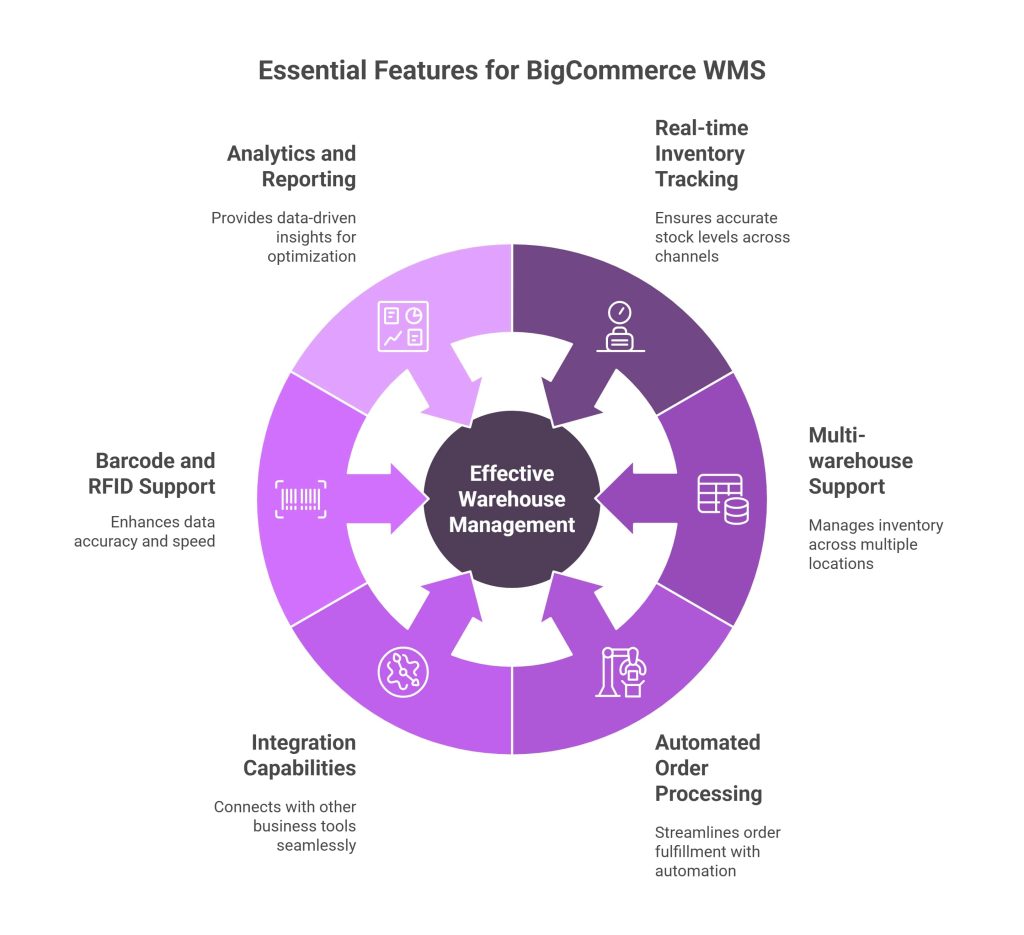
Integration Capabilities
Your WMS shouldn’t exist in isolation. Look for solutions that offer robust BigCommerce ERP integration India options, connecting with your accounting software, CRM systems, and other business tools you rely on.
Barcode and RFID Support
Barcode scanning BigCommerce WMS functionality eliminates manual data entry errors and speeds up receiving, picking, and shipping processes. For larger operations, RFID support can provide even more efficiency gains.
Analytics and Reporting
Data-driven decisions require good data. Your WMS should provide insights into picking efficiency, inventory turnover, order processing times, and other key metrics that help you optimize operations.
Best WMS Solutions for BigCommerce in India
Now, let’s talk about the best WMS for BigCommerce in India. Based on integration capabilities, local support, and suitability for the Indian market, here are the top solutions worth considering
Unicommerce
Unicommerce offers comprehensive BigCommerce logistics solutions India with a focus on omnichannel retail. Their platform is particularly strong for businesses that sell both online and offline.
Key strengths:
- Robust warehouse management features
- Strong analytics and reporting
- Multiple marketplace integrations
- Inventory optimization tools
- Established presence in Indian market
OmneelabWMS
OmneelabWMS provide flexibility and scalability without the infrastructure overhead. These cloud based solution are particularly attractive for smaller businesses looking to grow. omneelabWMS offers comprehensive warehouse management features with strong BigCommerce integration capabilities, making it an excellent choice for Indian businesses seeking reliable cloud-based inventory and order management solutions.
Key strengths:
- Real-time BigCommerce inventory synchronization
- Multi-warehouse management capabilities
- Automated order processing and fulfillment
- Cloud-based scalability for growing businesses
- Cost-effective pricing for SME businesses
Vinculum
Vinculum provides enterprise-grade warehouse automation for BigCommerce with particular strength in handling complex fulfillment scenarios. They’re ideal for larger operations with sophisticated requirements.
Key strengths:
- Advanced automation capabilities
- Customizable workflows
- Strong integration ecosystem
- Scalable architecture
- Industry-specific solutions
EasyEcom
EasyEcom has established itself as a strong player in the Indian ecommerce warehouse management space. Built specifically for the Indian market, it understands the complexities of managing inventory across multiple marketplaces while maintaining BigCommerce integration.
Key strengths:
- Native BigCommerce integration
- Multi-channel inventory sync
- Indian logistics partner integrations
- Local customer support
- Competitive pricing for growing businesses
Orderhive
While globally focused, Orderhive offers excellent BigCommerce WMS integration capabilities with features tailored for growing businesses. Their solution balances functionality with ease of use.
Key strengths:
- User-friendly interface
- Affordable pricing tiers
- Good integration capabilities
- Shipping optimization features
- Inventory forecasting tools
How Does WMS Integration Work with BigCommerce?
Understanding how a WMS integrates with BigCommerce is crucial for making an informed decision. The integration typically happens through APIs that allow real-time data exchange between your BigCommerce store and the warehouse management system.
The Integration Process
- API Connection Setup: Your chosen WMS connects to BigCommerce through official APIs
- Data Synchronization: Product information, inventory levels, and order data sync in real-time
- Workflow Configuration: Set up rules for order routing, fulfillment priorities, and exception handling
- Testing Phase: Thorough testing ensures all systems communicate correctly
- Go-Live: Full integration activation with monitoring for any issues
What Gets Synchronized?
A proper BigCommerce WMS integration should synchronize:
- Product catalogs and variants
- Real-time inventory levels
- Order information and customer details
- Shipping and tracking updates
- Return and refund processes
The key is ensuring this happens automatically without manual intervention, reducing the chance of errors and saving your team valuable time.
Benefits of Real-time Inventory Tracking
Real-time inventory sync benefits BigCommerce stores in ways that go beyond just preventing stockouts. When your WMS maintains accurate, up-to-the-minute inventory data across all sales channels, you unlock several competitive advantages:
Improved Customer Satisfaction
Nothing frustrates customers more than placing an order only to receive a cancellation email later. Real-time tracking ensures customers only see products that are actually available, leading to higher fulfillment rates and better customer experiences.
Better Cash Flow Management
Accurate inventory data helps you make smarter purchasing decisions. You’ll know exactly when to reorder, how much to order, and which products are moving fastest. This prevents both stockouts and overstock situations that tie up valuable working capital.
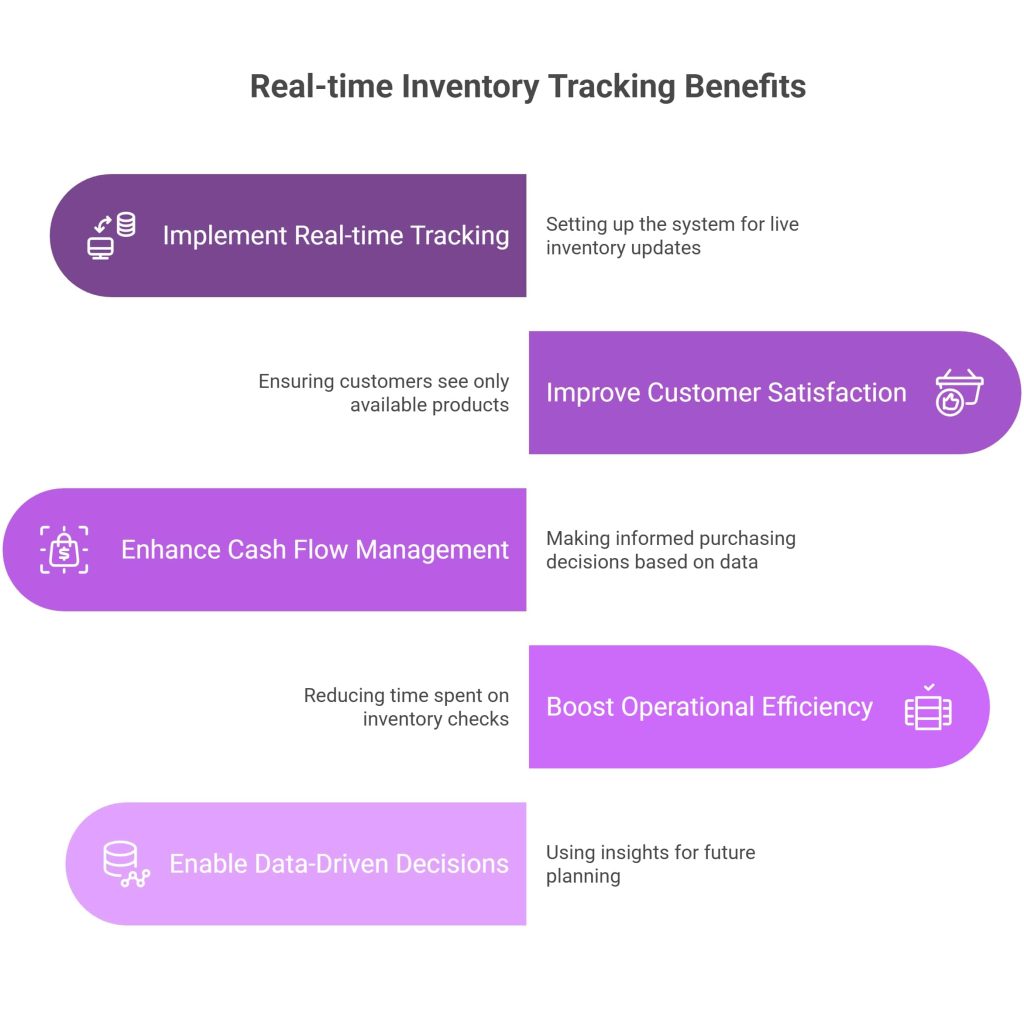
Enhanced Operational Efficiency
When your team has accurate, real-time data, they spend less time double-checking inventory and more time fulfilling orders. Pick accuracy improves, and fulfillment times decrease.
Data-Driven Decision Making
Real-time inventory data provides insights into product performance, seasonal trends, and customer preferences. This information becomes invaluable for planning future inventory purchases and marketing campaigns.
Multi-warehouse Management for Indian Businesses
Multi-warehouse management in India presents unique challenges that your WMS needs to address. As your business grows, you might operate warehouses in different cities to reduce shipping times and costs, or you might use a combination of your own facilities and third-party logistics providers.
Strategic Warehouse Distribution
A sophisticated warehouse management software for BigCommerce should help you optimize inventory distribution across locations. For example, keeping fast-moving products in metros like Mumbai and Delhi while storing seasonal items in lower-cost locations.
Automated Order Routing
The system should automatically determine the best fulfillment location based on factors like:
- Customer location
- Product availability
- Shipping costs
- Delivery speed requirements
- Warehouse capacity
Inventory Transfers
Sometimes you need to move inventory between warehouses to optimize stock levels or prepare for regional demand spikes. Your WMS should make inter-warehouse transfers simple and trackable.
Regional Compliance
Different states in India have varying tax requirements and regulatory needs. Your WMS should handle these regional differences automatically, ensuring compliance without manual intervention.
Automated Order Fulfillment with BigCommerce WMS
Automated order fulfillment BigCommerce capabilities can transform your operations from reactive to proactive. Instead of your team scrambling to process orders manually, automation handles routine tasks while your staff focuses on exceptions and customer service.
Pick List Optimization
Advanced WMS solutions optimize picking routes through your warehouse, reducing the time pickers spend walking between locations. Some systems even suggest the most efficient sequence for multi-item orders.
Intelligent Inventory Allocation
When you have a limited stock of popular items, the system can prioritize orders based on customer value, shipping method, or other criteria you define. This ensures your most important customers get priority during peak periods.
Automated Shipping Selection
The WMS can automatically select the most cost-effective shipping method based on package dimensions, weight, destination, and customer preferences. This optimization often pays for the WMS investment through shipping cost savings alone.
Exception Management
Not everything can be automated, but a good WMS identifies exceptions that need human attention while handling routine orders automatically. This includes situations like damage during picking, insufficient stock, or special shipping requirements.
Cloud-based vs On-premise WMS Solutions
The choice between cloud WMS for BigCommerce and on-premise solutions significantly impacts your implementation timeline, costs, and scalability options.
Cloud-based Advantages
Cloud-based WMS solutions offer several advantages for Indian ecommerce businesses:
- Faster Implementation: No hardware procurement or software installation delays
- Scalability: Easily handle seasonal spikes without infrastructure investments
- Automatic Updates: Always have the latest features without manual upgrades
- Lower Initial Costs: No large upfront hardware investments
- Remote Access: Manage operations from anywhere with internet connectivity
- Disaster Recovery: Built-in data backup and recovery capabilities
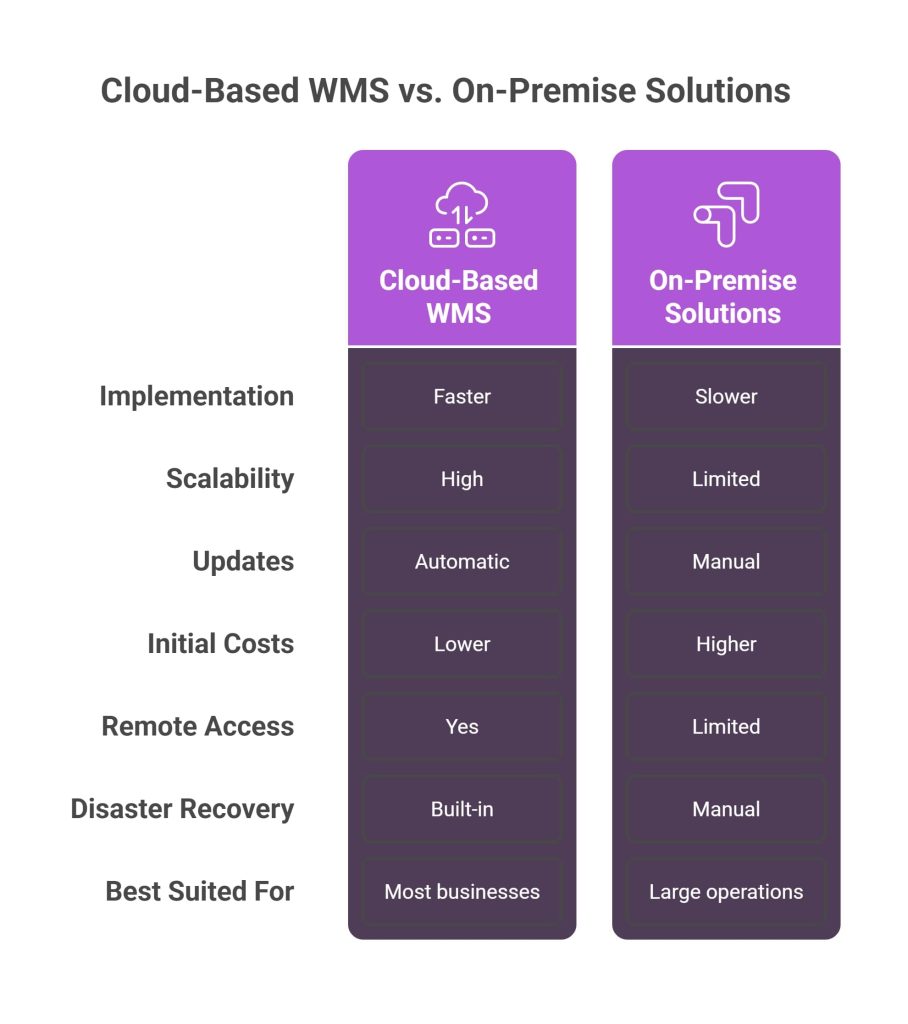
On-premise Considerations
While less common for growing businesses, on-premise solutions might make sense for:
- Very large operations with dedicated IT teams
- Businesses with specific customization requirements
- Companies with strict data residency requirements
- Organizations with existing infrastructure investments
For most Indian ecommerce businesses, cloud-based solutions provide the best balance of functionality, cost, and scalability.
Cost Considerations and ROI
Investing in warehouse management software for BigCommerce requires careful consideration of both upfront costs and long-term returns. Here’s how to think about the financial aspects:
Typical Cost Structure
Most BigCommerce WMS India solutions follow subscription-based pricing with costs varying based on:
- Number of orders processed monthly
- Number of SKUs managed
- Advanced features required
- Integration complexity
- Support level needed
Expect monthly costs ranging from ₹10,000 for basic solutions to ₹1,00,000+ for enterprise-grade systems.
ROI Calculation
Calculate your potential return on investment by considering:
Cost Savings:
- Reduced labor costs through automation
- Lower shipping costs through optimization
- Decreased inventory carrying costs
- Reduced error-related expenses
Revenue Improvements:
- Faster order processing leading to higher customer satisfaction
- Better inventory availability reducing lost sales
- Improved cash flow from optimized inventory levels
- Ability to handle higher order volumes without proportional staff increases
Most businesses see ROI within 6-12 months of implementation, with benefits continuing to compound as order volumes grow.
Implementation Best Practices
Successfully implementing a BigCommerce warehouse management system requires careful planning and execution. Here are key practices that ensure smooth deployment:
Pre-Implementation Planning
Before selecting a WMS, document your current processes, pain points, and growth projections. This helps you choose a solution that fits both current needs and future requirements.
Data Cleanup
Clean, accurate data is crucial for WMS success. Before implementation, audit your product information, SKU naming conventions, and inventory records. Fix inconsistencies early to avoid complications later.
Staff Training
Your team’s adoption of the new system determines its success. Invest in comprehensive training and provide ongoing support as staff learn new processes.
Phased Rollout
Rather than switching everything at once, consider a phased approach. Start with core functionality and gradually add advanced features as your team becomes comfortable with the system.
Performance Monitoring
Establish key performance indicators (KPIs) before implementation so you can measure the WMS impact on your operations. Track metrics like order processing time, pick accuracy, and inventory turnover.
Future-Proofing Your WMS Investment
As India’s ecommerce landscape continues evolving, your WMS for BigCommerce should adapt to new requirements and opportunities.
Emerging Technologies
Look for solutions that are actively incorporating:
- Artificial Intelligence: For demand forecasting and inventory optimization
- Machine Learning: To improve picking efficiency and predict maintenance needs
- IoT Integration: For real-time equipment monitoring and environmental controls
- Mobile Optimization: As mobile commerce continues growing in India
Scalability Planning
Your chosen solution should handle not just your current volume but also significant growth. Consider systems that can scale both vertically (more features) and horizontally (more locations or channels).
Integration Ecosystem
The best WMS solutions offer extensive integration possibilities. As your business grows, you’ll likely add new tools for accounting, customer service, marketing automation, and analytics. Choose a platform that plays well with others.
Conclusion
Implementing the right WMS for BigCommerce isn’t just about solving today’s problems – it’s about building a foundation for sustainable growth in India’s dynamic ecommerce market. The solutions we’ve discussed offer different strengths, but they all share the ability to transform your warehouse operations from a constant source of stress into a competitive advantage.
Remember, the best warehouse management software for BigCommerce is the one that fits your specific needs, budget, and growth trajectory. Whether you choose EasyEcom for its local market focus, Unicommerce for omnichannel capabilities, or a cloud-based solution for flexibility, the key is taking action.
Don’t let inefficient warehouse operations hold back your BigCommerce store’s growth potential. Start evaluating these solutions today, and take the first step toward transforming your fulfillment operations.
Ready to revolutionize your warehouse operations? Contact the WMS providers mentioned in this guide for demos and see firsthand how the right system can transform your BigCommerce store’s efficiency and customer satisfaction.
Frequently Asked Questions
1. What is the best WMS for BigCommerce in India?
The best WMS for BigCommerce in India depends on your specific requirements, but omneelabWMS is a top choice for businesses seeking cloud-based scalability with cost-effective warehouse management solutions. EasyEcom excels for growing businesses with native BigCommerce integration, while Unicommerce handles omnichannel operations effectively. Vinculum offers enterprise-grade automation for larger operations. Consider your order volume, budget, and integration needs when making your decision.
2. How does a WMS integrate with BigCommerce for real-time inventory sync?
WMS integration with BigCommerce happens through official APIs that enable real-time data exchange. When an order is placed on your BigCommerce store, the information instantly flows to your WMS, which then updates inventory levels across all sales channels. This real-time inventory sync prevents overselling and ensures accurate stock visibility. The integration also handles product information, shipping updates, and return processes automatically, eliminating manual data entry and reducing errors.
3. Can a WMS help with multi-warehouse management in India?
Yes, a sophisticated WMS for BigCommerce excels at multi-warehouse management in India. The system can automatically route orders to the optimal fulfillment location based on factors like customer proximity, product availability, and shipping costs. It handles inventory transfers between warehouses, manages regional compliance requirements, and provides unified visibility across all locations. This is particularly valuable for Indian businesses dealing with diverse geographic markets and varying state-level regulations.
4. What features should I prioritize in a BigCommerce WMS for my Indian ecommerce business?
Essential features for BigCommerce WMS India operations include real-time inventory tracking, multi-channel synchronization, automated order routing, and barcode scanning capabilities. Look for systems offering multi-warehouse support, integration with Indian logistics partners, automated shipping selection, and comprehensive analytics. Cloud-based deployment, mobile accessibility, and local customer support are also crucial for Indian businesses. The system should handle seasonal volume spikes common during festival periods and integrate with popular Indian payment gateways.
5. How much does implementing a WMS for BigCommerce cost in India?
WMS for BigCommerce costs in India typically range from ₹10,000 to ₹1,00,000+ per month, depending on order volume, features, and complexity. Most solutions follow subscription-based pricing with tiers based on monthly orders processed or SKUs managed. Factor in implementation costs, training expenses, and potential customization needs. However, most businesses achieve ROI within 6-12 months through reduced labor costs, improved efficiency, lower shipping expenses, and decreased inventory carrying costs. Many providers offer flexible pricing and free trials to help you evaluate the investment.
People also read:
- WMS for Magento
- WMS for WooCommerce
- Last Mile Delivery Stations in India
- WMS for Last Mile in India
- Small Business Barcoding
- Demand-driven Replenishment Practices for Retailers
- Guide to Managing Perishable Inventory
- What Is a Bill of Materials (BOM)? Expert Guide & Tips
- Inventory Management with Barcode Technology
- Common Inventory Management Challenges

Kapil Pathak is a Senior Digital Marketing Executive with over four years of experience specializing in the logistics and supply chain industry. His expertise spans digital strategy, search engine optimization (SEO), search engine marketing (SEM), and multi-channel campaign management. He has a proven track record of developing initiatives that increase brand visibility, generate qualified leads, and drive growth for D2C & B2B technology companies.